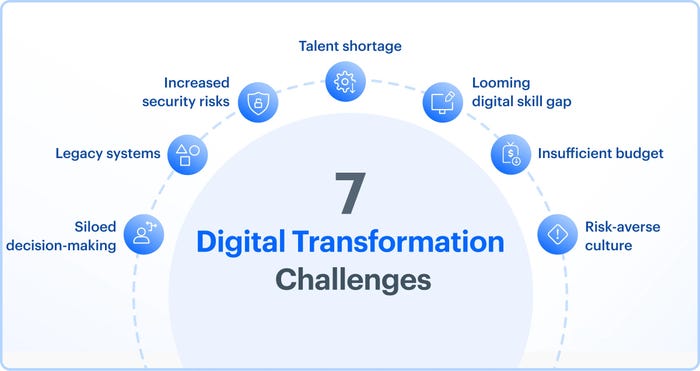The Digital Transformation Ain’t Easy
Deploying the software may be a breeze, but getting the new system to work with your company’s culture can be a tough climb.
April 18, 2024

At a Glance
- The Technology isn't everything in digital transformation.
- The implementation strategy matters.
- Most organizations fail at first during their digital transformation.
According to a study from Boston Consulting Group, a surprising 70% of digital transformations fail. It’s anticipated that in 2024, more than $3.4 trillion will be spent by organizations seeking to transform their business, meaning that $2.38 trillion will be spent by organizations as they fail to fully achieve their goals.
A McKinsey’s report on digital transformation found the difficulty companies experience include “insufficiently high aspirations, a lack of engagement within the organization, and insufficient investment in building capabilities across the organization to sustain the change.”
Digital platform company Kissflow, offered a chart chowing the seven difficulties in implementing a digital transformation:

Image courtesy of Kissflow.
We caught up with Pablo Alejo, managing director of the Product Experience & Engineering Lab at West Monroe, to get his take on the challenges of implementing a digital transformation. West Monroe is a company that develops strategies for an effective digital transformation.
Tell us about your experience in overseeing digital transformations.
Pablo Alejo: Since the early 2000s, I’ve worked extensively with Fortune 500 companies to create digital experiences. I watched organizations attempt transformation in the manufacturing world. The complexity of this transformation is a massive spectacle. Everyone plans the transformation thinking it’s an easy thing. They say, “Let me use this technology, and that will help my company transform.” That is never the experience.
What is the most important aspect to focus on?
Pablo Alejo: The culture. Organizations believe you can acquire capability and train people to do it and expect that to transform the organization. Instead, they need to create the culture needed to transform. AT&T partnered with Salesforce. The Salesforce CEO was in Hawaii and his phone messed up, so he went to the local AT&T store. He expected the employee at the store to know how to fix the issue. The store didn’t have the right equipment. So later, he reached out to AT&T and said, “Let us help you transform how you think about your customer.”
What does a typical transformation failure look like?
Pablo Alejo: The organization does not have all of the parts needed and it doesn’t have a full buy-in from its employees and management to implement the solution. Many organizations are siloed as an institution. There is not a vision of what good customer service looks like. Accounting does one thing, sales does another, and they didn’t come together. Production is somewhere else. You have to get the entire culture to embrace the new system. Organizations that have difficulty usually don’t start with people.
Is digital transformation expensive?
Pablo Alejo: It is if you don’t do it right. The reason why it gets expensive is that it requires so much rework if it’s not done right. The entire workforce puts in time and effort in one direction, and now you have to pivot. You end up spending almost as much time and effort on the rework as you spent on the original work. If applied correctly, digital systems are wonderful technology. But it comes down to keeping every part of the organization aligned, and you have to have the culture to embrace the change. I see many organizations struggling.
I’ve seen companies using good technology, but they’ll switch integrators in the middle of the transformation. Like you’re moving from Google to Microsoft communication programs. They’re easy to install, but a CRM or HR platform may not be integrated into how people do their business. It may be easy to install software, but integrating a full ERP system can be difficult. They don’t need to replace the system as much as they need to replace those who are implementing the system.
Does that mean the digital transformation failure is not because of the technology involved?
Pablo Alejo: More and more, you have to go beyond the implementation of technology to process excellence. You have to go to the integration of the capability and transforming of the implementation. The organizations that are doing it well work harmoniously within their organization rather. The failures are with companies that are piecemealing it together. That’s a disjointed experience.
You can’t just go in and sell your technology. There was 4.3 trillion spent on digital transformation in 2022. If 70% of those transformations fail (it used to be 94%), that’s $3.8 trillion that was not fully realized. The medical and finance industries are laggard compared to automation and manufacturing. You can’t afford a bad implementation in automotive. Retail organizations are also not failing as much. They can’t because of the competition they face.
About the Author(s)
You May Also Like





